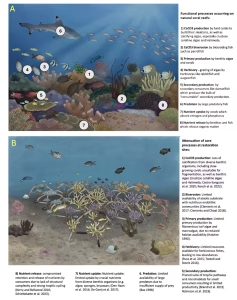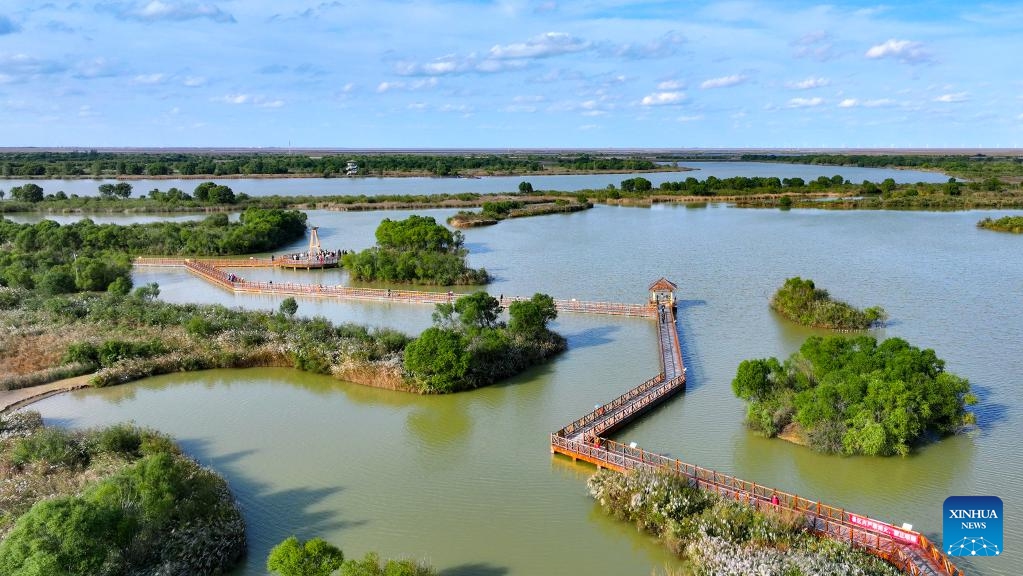Reef restoration shouldn’t just be about growing corals – but also bringing reefs to life, new study suggests – The Invading Sea

Report on Enhancing Coral Reef Restoration Efficacy in Alignment with Sustainable Development Goals
A comprehensive review of global coral reef restoration efforts over the past two decades indicates a critical need for a strategic shift in methodology. Current practices, while widespread, often fall short of achieving long-term ecological viability, thereby limiting their contribution to key United Nations Sustainable Development Goals (SDGs), particularly SDG 14 (Life Below Water).
Analysis of Current Restoration Methodologies
A Narrow Focus on Growth Metrics
A significant portion of reef restoration programs measure success using rudimentary indicators such as coral cover and growth rates. While these metrics are simple to collect, they provide an incomplete assessment of reef health and fail to capture the complexity of a living ecosystem. This approach prioritizes short-term, visible results over the establishment of a resilient and self-sustaining marine habitat, a core tenet of SDG 14.
The Missing Component: Ecosystem Functioning
The critical missing element in many restoration initiatives is the concept of “ecosystem functioning”—the intricate web of energy and nutrient transfers among all reef organisms, including corals, fish, sponges, and algae. Key functional processes are often overlooked in projects that focus solely on transplanting fast-growing coral species. This oversight results in restored sites that may appear successful but lack the biodiversity and complexity required to support the long-term objectives of several SDGs.
- SDG 14 (Life Below Water): A focus on coral cover alone does not guarantee the restoration of marine ecosystems or the conservation of marine biodiversity.
- SDG 13 (Climate Action): Projects often use coral species that are highly sensitive to thermal stress, undermining the long-term resilience of restoration efforts in the face of climate change.
- SDG 1 (No Poverty) & SDG 2 (Zero Hunger): The failure to restore fully functional reefs limits their capacity to support coastal communities dependent on marine resources for livelihoods and food security.
A Proposed Framework for Functional Restoration Aligned with SDGs
To ensure that the substantial global investment in reef restoration yields meaningful and lasting results, a paradigm shift is required. The ultimate goal must be the creation of ecologically functional reefs that are resilient and contribute directly to global sustainability targets. The following three-step framework is proposed.
-
Measure and Monitor Ecosystem Functioning
Long-term monitoring that extends beyond simple growth metrics is essential. Programs must incorporate assessments of key functional processes to determine if restoration efforts are genuinely rebuilding a living ecosystem. This data-driven approach is vital for accountability and for achieving the conservation and management targets of SDG 14.
-
Integrate Climate Change Resilience (SDG 13)
Restoration strategies must proactively address the impacts of climate change. This involves moving beyond fast-growing but vulnerable coral species to include a diverse mix of corals with higher tolerance to thermal stress. This approach directly supports SDG 13 by building adaptive capacity and resilience to climate-related hazards. Emphasizing the maintenance of ecosystem processes ensures that reefs can continue to provide some ecological services even if coral populations decline, securing long-term value.
-
Protect Functionally Important Species
A holistic approach requires identifying and protecting the diverse suite of organisms—the “unsung heroes”—that perform key functions on a reef. From herbivorous fish that control algae to sponges that filter water, these species are integral to a reef’s health. Restoration and management plans must expand their scope to protect this functional biodiversity, which is the foundation of a healthy marine ecosystem as envisioned by SDG 14.
Conclusion: From a Sprint to a Marathon
Effective coral reef restoration must be reconceptualized not as a sprint to maximize coral cover, but as a marathon to rebuild the complex web of relationships that define a functional ecosystem. By adopting a long-term, functional perspective that is explicitly aligned with SDG 14 (Life Below Water) and SDG 13 (Climate Action), future programs can maximize their ecological value and contribute meaningfully to global marine conservation and sustainable development.
Analysis of Sustainable Development Goals in the Article
1. Which SDGs are addressed or connected to the issues highlighted in the article?
-
SDG 14: Life Below Water
This is the most central SDG to the article. The entire text focuses on the conservation and restoration of coral reefs, which are critical marine ecosystems. The article discusses methods, challenges, and the ultimate goal of restoration efforts, which directly aligns with the objective of conserving and sustainably using the oceans, seas, and marine resources.
-
SDG 13: Climate Action
The article explicitly identifies climate change as a “primary driver of reef decline.” It argues that restoration efforts must account for climate-related impacts such as rising ocean temperatures, heat stress, and bleaching events. The recommendation to use heat-tolerant coral species is a direct adaptation strategy to combat the effects of climate change on marine ecosystems.
-
SDG 17: Partnerships for the Goals
The article mentions that coral reef restoration has seen “unprecedented growth worldwide,” with “thousands of projects” and “millions of dollars of funding globally.” This points to a global partnership of governments, non-profits, and scientific institutions. Furthermore, the article itself, as a scientific paper, contributes to the goal of enhancing scientific cooperation and knowledge sharing to address sustainability challenges.
2. What specific targets under those SDGs can be identified based on the article’s content?
-
SDG 14: Life Below Water
- Target 14.2: “By 2020, sustainably manage and protect marine and coastal ecosystems to avoid significant adverse impacts, including by strengthening their resilience, and take action for their restoration in order to achieve healthy and productive oceans.” The article is fundamentally about taking “action for their restoration” (coral reefs). It critiques current methods that provide only “short-term fixes” and calls for a new approach focused on “ecosystem functioning” to truly achieve resilient, healthy, and functional marine ecosystems.
- Target 14.a: “Increase scientific knowledge, develop research capacity and transfer marine technology… in order to improve ocean health…” The article is a scientific paper that calls for a “major rethink of how reefs should be restored.” It proposes a new framework for measuring success, thereby contributing directly to increasing the scientific knowledge and research capacity needed to improve the health of coral reef ecosystems.
-
SDG 13: Climate Action
- Target 13.1: “Strengthen resilience and adaptive capacity to climate-related hazards and natural disasters in all countries.” The article directly addresses this by advocating for restoration techniques that strengthen the resilience of coral reefs to climate-related hazards. It specifically suggests transplanting “a more diverse mix of corals, including ones which may be more tolerant to heat stress” to withstand “future bleaching events” caused by warming oceans.
3. Are there any indicators mentioned or implied in the article that can be used to measure progress towards the identified targets?
Yes, the article discusses both existing and proposed indicators for measuring the success of coral reef restoration.
- Currently Used (but criticized) Indicators: The article states that a “large portion of reef restoration programs measures their progress using basic indicators such as coral cover and growth.” It argues these are insufficient because they “only tell part of the story” and do not reflect the overall health of the ecosystem.
- Proposed/Implied Indicators: The article advocates for a new set of indicators centered on “ecosystem functioning.” While it refers to a separate paper for full details on “eight key functional processes,” it implies the following can be used as indicators:
- Measures of Ecosystem Functioning: Quantifiable data on the transfer and retention of energy and nutrients by reef organisms.
- Species Diversity: The presence of a “diverse mix of corals” rather than a monoculture of fast-growing species.
- Climate Resilience: The proportion of heat-tolerant coral species (e.g., Platygyra daedalea) used in restoration sites.
- Habitat Complexity: The structural diversity of the restored reef, which is crucial for supporting a wide range of organisms.
- Presence of Key Functional Species: The existence of “stable populations of functionally important flora and fauna,” such as specific fish, sponges, and algae, which are identified as the “unsung heroes of the reef.”
- Long-term Monitoring Data: The article criticizes projects with “less than 18 months of monitoring data,” implying that a key indicator of a successful, well-managed project is the collection and analysis of long-term data (over 18 months) on ecosystem health.
4. Table of SDGs, Targets, and Indicators
| SDGs | Targets | Indicators |
|---|---|---|
| SDG 14: Life Below Water |
14.2: Manage and protect marine and coastal ecosystems and take action for their restoration.
14.a: Increase scientific knowledge and research capacity to improve ocean health. |
|
| SDG 13: Climate Action | 13.1: Strengthen resilience and adaptive capacity to climate-related hazards. |
|
| SDG 17: Partnerships for the Goals | 17.6: Enhance knowledge-sharing on science, technology and innovation. |
|
Source: theinvadingsea.com
What is Your Reaction?
 Like
0
Like
0
 Dislike
0
Dislike
0
 Love
0
Love
0
 Funny
0
Funny
0
 Angry
0
Angry
0
 Sad
0
Sad
0
 Wow
0
Wow
0




















































.jpg.webp?itok=0ZsAnae9#)

























